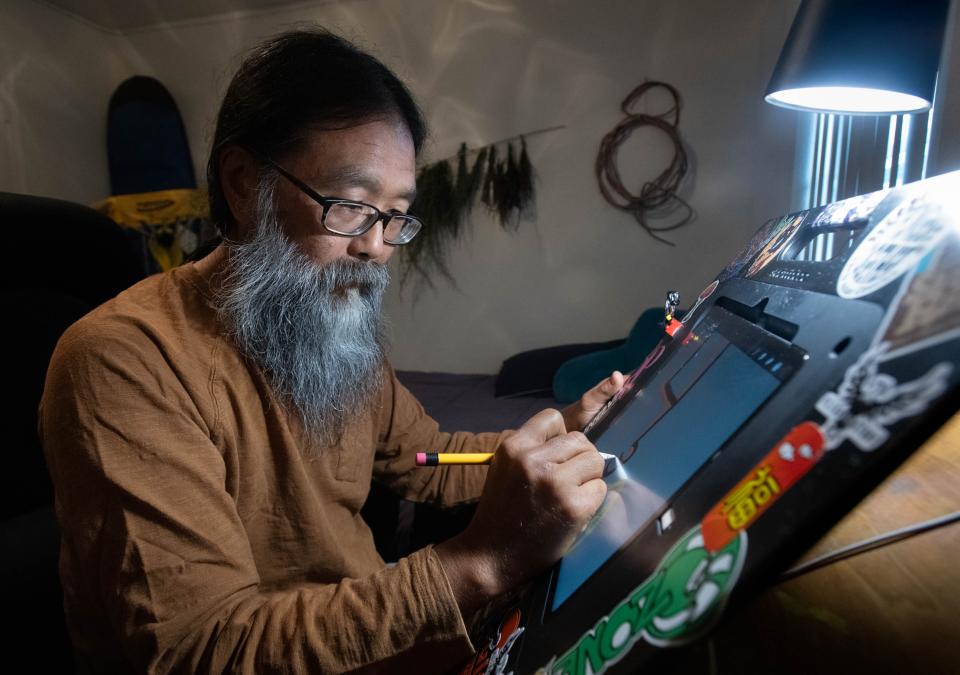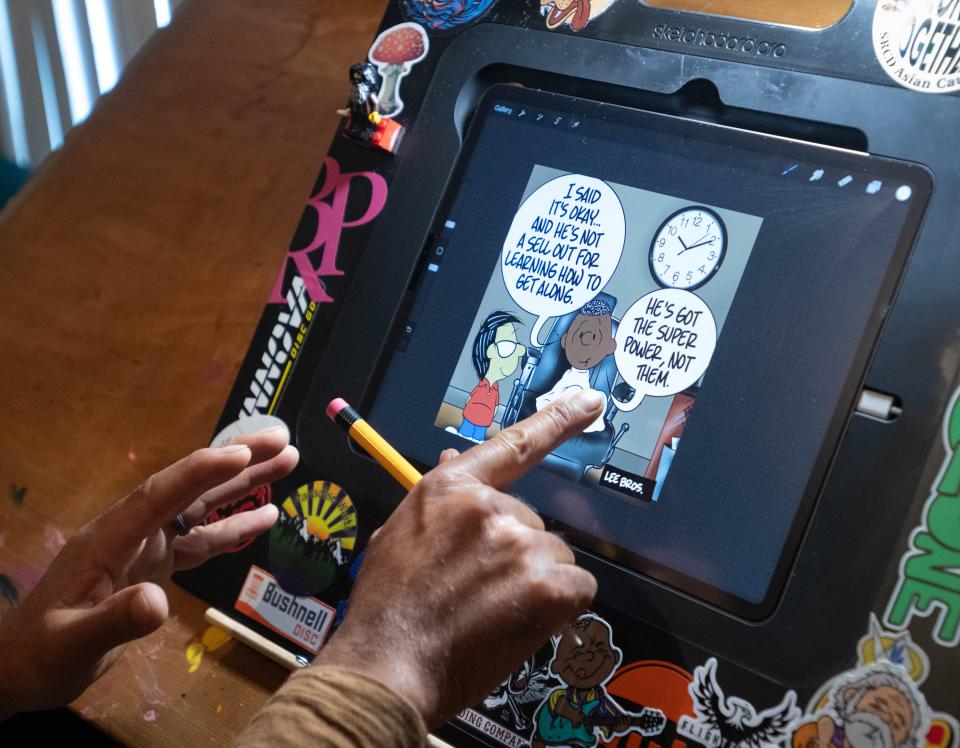Pensacola cartoonist explores immigrant life with "The Other Ones by Lee"
- Oops!Something went wrong.Please try again later.
Martin Lee was lost when I first met him. Literally, not in some life-encompassing figurative sense.
My brother and I were playing disc golf out at the University of West Florida in October 2022, and we saw two discers kinda wandering around wondering where to find the next tee box. We pointed them in the right direction, then asked if they wanted to join us on our round.
One of those guys was Martin and I liked him from the beginning. We were both pretty similar. Not the tallest dudes. Both of us were kinda shaggy, and both of us were sporting glorious scruffy black and gray-white beards. Big music nerds. We were similar except for one glaring and big distinction. He's a Deadhead. I'm pretty much not.
Still, I liked him right away and we've been hanging ever since. (I had to text him a few minutes ago for a bit more information for this story. He replied and asked if I could play disc golf. No, brother. I'm writing about how cool you are.)
Right away, I found out Martin was a talented artist, who even collaborated on a daily comic strip, "The Other Ones,'' with his brother Rich Lee, a University of Minnesota psychology professor. "The Other Ones" is the name of a Grateful Dead song, which I didn't know at first. "The Other Ones" are also the thoughtful, sometimes funny, often contemplative young characters who inhabit the brothers' comic strip, a strip that exists somewhere on the across-the-track fringes of the classic "Peanuts" world of Charles Schulz and which deals with the joys, challenges and complexities of life for persons of color, largely focusing on immigrants and the children of immigrants.

The Lees are of Korean heritage. Their father, Ung Lim Lee, was born in what is now North Korea − the country was under Japanese rule then− and their mother, Young Hee Lee, in South Korea.
The brothers' strip is truly collaborative. Martin does all the artwork and illustrations, while Rich provides the text. It didn't start that way. Martin started drawing a strip on his own a few years back.
He was cooped up during the pandemic, already feeling isolated and the news didn't help. News beyond viruses and the upheaval they caused. It was news of an ugly, violent nature.
"There were Asian grandmothers getting beaten with rocks, just out of the blue," he said. "All the George Floyd stuff was happening."
He would send the strips to his brother in Minnesota.
"(Rich Lee) would start saying he liked the content, but they're so angry,'' Martin said. "I know what you're trying to do, but they're so bitter and I told him that's how I feel. He told me there's a better way to get the message across. He's a psychologist, that's what he does. He was right."
Since then, the Lees have created more than 1,200 "The Other One" comic strips, trying to post one a day. You can see the strip on most of the major social media platforms − Facebook, Instagram, YouTube included − by searching "The Other Ones by Lee."
What you'll find are young characters of color − there are no white folks in the strip − talking about their problems living in a society that often views them as "the other ones."
The strip tackles racism, trauma, dreams and hopes that the young characters who live in the world. Martin created the strip's main character, "Diggy," in tribute to resemble his brother. "The Other Ones" imagines what the children surrounding "Charlie Brown's" neighborhood were doing while the "Peanuts" gang was having its adventures. Take a peek. Poignant, touching stuff. Stuff that I don't have to deal with as the grandson of an Italian immigrant. Italian-American skin doesn't often attract the glances and questions that Asian-American skin does.

"Because I study the cultural, racial and ethnic experiences of youth and families from immigrant and minoritized backgrounds, particularly Asian American communities, I started to give my two cents on the subject," Rich Lee said via email. "And soon, we expanded the comic beyond Diggy and a few friends. We also have really shifted away from just being a racial parody to creating our own brand of comic that can be a vehicle for centering and normalizing the life experiences of kids of color with diverse identities and backgrounds."
Martin and Rich went to nearly all-white schools growing up, and racism − in various degrees − was always lurking. He saw kids pull back their skin around their eyes, mocking Asian facial characteristics. There were the stares.
"Do you how tiresome it is after 56 years to have people just come up to you and ask, 'Where are you from?' I was born in Hartford, Connecticut. That would be the answer. It's just old."
The brothers' father is a longtime commercial artist who recently, at age 90, had his first public art show, an exhibit during the spring at the Xia Gallery in St. Paul, Minnesota, where he resides with Rich Lee. The brothers' mother died years ago.
Martin said that as a young man, he didn't pay much attention to his father's stories of Korea. His grades suffered. He became disillusioned and depressed trying to figure out how he fit in a society that often viewed him, he felt, as one of "the other ones." He dropped out of college and was even suicidal.
"I wanted to assimilate, hard," he said. "I didn't want to stand out or get noticed as a Korean American."
My own biases came out early on. I have been deeply interested in Korean history, particularly the history of North Korea and its cult of personality. So I would ask Martin questions about North Korea − the "Arduous March," the wacky haircut restrictions, Juche philosophy, etc. − and was surprised when we both realized I knew a lot more about it than he did. I don't know why I was surprised. I don't know diddly about Italian history, other than from the World War II period. But for some reason, I assumed he would know it all.
"I wanted nothing to do with it," Martin told me. "I'm older than my brother and I did everything to assimilate. I dropped out, became a hippie and estranged from most of my family."
The brothers communicate mainly by text.
"We've reconnected," Martin said. "My little brother was always the communicator. He was the one who would find out what was going on with me and tell my parents how I was doing. We don't talk on the phone really, but communicate about the comic and our personal lives through text."
Martin has worked as a schoolteacher, an organic farmer and currently spends some of his time co-creating "The Other Ones" strip and teaching part time. A lot of his time goes toward disc golf − he averages 36 holes a day. That text from earlier asking me about maybe playing disc golf? He was coming back from 18 holes at the Pat Lunsford Blackwater Disc Golf Course in Milton and wanting to play more. But he always makes time for "The Other Ones by Lee." It's part therapy for him, he said, and serves an educational role. And brother Rich is using the comic strip for educational purposes as well.
For the disc golf fans: Pensacola brings pro disc golf tournament to downtown, along with sport icon Paige Pierce
"As we have developed 'The Other Ones by Lee,' we have learned that some school teachers in middle and high schools have begun to use the comics to illustrate topics and issues being taught in class or even as an ice breaker to a subject," Rich Lee said via email. "I know it's also used by college professors to demonstrate psychological concepts like discrimination, identity development, acculturation, parent-child relationships and ethnic-racial socialization. In my current work, I am using the comics to illustrate study findings from our research on transracially adopted children and adolescents, such as Korean adoptees raised in white families. I am finding that comics are an accessible, relatable, and disarming approach to address issues that are difficult to articulate or talk about with others."
Martin said one of the comics features a Korean girl's adoptive white parents who claim at one point "not to see color." That's the wrong approach, he said.
"Your child is of color," he said. "When you say 'I don't see color' then you are saying 'I don't see you.'"
Martin's a great guy and I dig him. I'm sure Rich is cool too. I hope you'll give their comic a peek.
(I just checked my texts and have one from Martin. He said he got an emergency call from another buddy to play another round of disc golf.)
This article originally appeared on Pensacola News Journal: Pensacola cartoonist "The Other Ones" strip explores immigrant life

